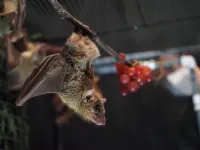(Press-News.org) URBANA, Ill. – Leafy green vegetables are important sources of dietary fiber and nutrients, but they can harbor harmful pathogens. In particular, lettuce has often been involved in outbreaks of foodborne illness across the U.S. A new study from the University of Illinois Urbana-Champaign examines factors that affect E. coli contamination on five different leafy greens – romaine lettuce, green-leaf lettuce, spinach, kale, and collards.
“We are seeing a lot of outbreaks on lettuce, but not so much on kale and other brassica vegetables. We wanted to learn more about the susceptibility of different leafy greens,” said lead author Mengyi Dong, now a postdoctoral research associate at Duke University. Dong conducted the research as a doctoral student in the Department of Food Science and Human Nutrition (FSHN), part of the College of Agricultural, Consumer and Environmental Sciences (ACES) at the U. of I.
The researchers infected whole leaves from each of the five vegetables with E. coli O157:H7 and observed what happened after storage at 4° C (39° F), 20° C (68° F), and 37° C (98.6° F). Overall, they found that susceptibility was determined by a combination of temperature and leaf surface properties such as roughness and the natural wax coating.
“At room temperature or higher, E. coli grows very fast on lettuce, but if lettuce is refrigerated at 4° C (39° F), we see a sharp decline in the E. coli population. However, for waxy greens like kale and collard, we get the opposite results. On these vegetables, E. coli grows slower under warmer temperatures, but if it is already present, it can survive longer under refrigeration.”
Even so, kale and collard are overall less susceptible to E. coli contamination than lettuce. Furthermore, these vegetables are usually cooked – which kills or inactivates E. coli – while lettuce is consumed raw. Rinsing lettuce does help, Dong said, but doesn’t remove all the bacteria because of their tight attachment to the leaf.
The researchers also inoculated cut leaves with E. coli O157:H7 to compare the intact surface of a whole leaf to the damaged surface of a cut leaf.
“Whole leaves and freshly cut leaves present different situations. When the leaf is cut, it releases vegetable juice, which contains nutrients that stimulate bacterial growth,” Dong explained. However, the researchers found that spinach, kale, and collard juice actually exhibited antimicrobial properties that protect against E. coli.
To further explore these findings, they isolated juice (lysate) from kale and collards and applied the liquid to lettuce leaves, finding that it can be used as a natural antimicrobial agent. The potential applications could include antimicrobial spray or coating to control foodborne pathogen contaminations at both pre-harvest and post-harvest stages, the researchers said.
“We can’t completely avoid pathogens in food. Vegetables are grown in soil, not in a sterile environment, and they will be exposed to bacteria,” said co-author Pratik Banerjee, associate professor in FSHN and Illinois Extension specialist.
“It’s a complex problem to solve, but we can embrace best practices in the food industry and food supply chain. There's a lot of interest from the research community and federal agencies to address these issues, and the USDA imposes high standards for food production, so overall the U.S. food supply is quite safe.”
Banerjee and Dong emphasize they do not want to discourage people from eating fresh fruit and vegetables; they are part of a healthy diet. Just follow food safety guidelines, wash your lettuce thoroughly, store it in the refrigerator, and pay attention to any food safety recalls in your area, they conclude.
The paper, “Fates of attached E. coli o157:h7 on intact leaf surfaces revealed leafy green susceptibility,” is published in Food Microbiology [DOI: 10.1016/j.fm.2023.104432]. Authors are Mengyi Dong, Maxwell J. Holle, Michael J. Miller, Pratik Banerjee, and Hao Feng.
This project was supported by the USDA Specialty Crop Block Grant Program (SCBGP) through the Illinois Department of Agriculture [grant numbers IDOA SC-22-20].
END
Refrigerate lettuce to reduce risk of E. coli contamination, researchers say
2024-02-29
ELSE PRESS RELEASES FROM THIS DATE:
How cognition changes before dementia hits
2024-02-29
Individuals with mild cognitive impairment, especially of the “amnestic subtype” (aMCI), are at increased risk for dementia due to Alzheimer’s disease relative to cognitively healthy older adults. Now, a study co-authored by researchers from MIT, Cornell University, and Massachusetts General Hospital has identified a key deficit in people with aMCI, which relates to producing complex language.
This deficit is independent of the memory deficit that characterizes this group and may provide an additional “cognitive biomarker” to aid in early detection — the time when treatments, ...
Notre Dame literacy research can improve learning outcomes and fight global poverty
2024-02-29
A new study by a team of University of Notre Dame researchers makes a significant contribution to understanding the factors that influence how young elementary school students respond to reading interventions in fragile and low-income contexts.
The study, published in the Comparative Education Review, evaluated an early-grade literacy intervention in Catholic schools in Haiti. The study has important implications for addressing educational inequities and improving learning outcomes to create opportunity and lift millions of children globally out of poverty.
“This ...
A holistic framework for studying social emotions
2024-02-29
(Santa Barbara, Calif.) — The crucial role of social emotions in our lives and in society cannot be overstated. Empathy, guilt, embarrassment, pride and other feelings we experience in the context of other people govern and motivate how we act, interact and the countless decisions we make. Which is why a more holistic approach, one that integrates the various ways these emotions are studied, is necessary to gain insight and address gaps in knowledge. That’s according to researchers from UC Santa Barbara, New York University School ...
Astronomers measure heaviest black hole pair ever found
2024-02-29
Nearly every massive galaxy hosts a supermassive black hole at its center. When two galaxies merge, their black holes can form a binary pair, meaning they are in a bound orbit with one another. It’s hypothesized that these binaries are fated to eventually merge, but this has never been observed [1]. The question of whether such an event is possible has been a topic of discussion amongst astronomers for decades. In a recently published paper in The Astrophysical Journal, a team of astronomers have presented new insight into this question.
The team used data from the Gemini North telescope in ...
Specific brain support cells can regulate behaviors involved in some human psychiatric disorders
2024-02-29
UCLA Health researchers have discovered a group of specialized support cells in the brain that can regulate behaviors associated with human neuropsychiatric disorders.
The study, published in the journal Nature, focused on a group of cells known as astrocytes – star-shaped cells that tile the central nervous system and provide a support structure for the neural communication networks.
While neurons have long been understood to have primary control of behavior, the study found that a distinct group of astrocytes located deep in the central region of the brain, known as the central striatum, may also regulate communications between neurons. Unlike ...
Microbial viruses act as secret drivers of climate change
2024-02-29
COLUMBUS, Ohio – In a new study, scientists have discovered that viruses that infect microbes contribute to climate change by playing a key role in cycling methane, a potent greenhouse gas, through the environment.
By analyzing nearly 1,000 sets of metagenomic DNA data from 15 different habitats, ranging from various lakes to the inside of a cow’s stomach, researchers found that microbial viruses carry special genetic elements for controlling methane processes, called auxiliary metabolic genes ...
Shining a light on the effects of habituation and neural adaptation on the evolution of animal signals
2024-02-29
A new paper published in The Quarterly Review of Biology examines the possible effects of two properties of receiver playing fields documented in studies of animal psychology—habituation and neural adaptation—on the efficacy of mate choice signals.
In “A Bridge between Animal Psychology and Sexual Selection: Possible Effects of Habituation and Neural Adaptation on Mate Choice Signals,” William G. Eberhard notes that researchers have paid little attention to habituation and neural adaptation in relation to sexual selection.
Eberhard argues in favor of adding further dimensions to studies of female choice, noting that standard ...
The secret lives of roots: Tropical forest root systems are central to improving climate change predictions
2024-02-29
International research co-authored by Joshua Fisher, associate professor in Chapman University’s Schmid College of Science and Technology, suggests that studying root function in tropical forests could help vegetation models improve predictions of climate change. Their study was published on Feb. 28 in New Phytologist.
When it comes to understanding climate change, vegetation models are vital tools that help scientists study plants’ adaptation strategies to changing environmental conditions, including drying, warming and elevated carbon ...
Similar genetic elements underlie vocal learning in mammals
2024-02-29
The vocalizations of humans, bats, whales, seals and songbirds vastly differ from each other. Humans and birds, for example, are separated by some 300 million years of evolution. But scientists studying how these animals learn to "speak" have time and again seen surprising similarities in the connections in brain regions that support this vocal learning.
In a paper published in the journal Science, a multi-institutional team led by scientists at Carnegie Mellon University and the University of California, ...
Q&A: How a potential treatment for Alzheimer’s disease could also work for Type 2 diabetes
2024-02-29
Of the 38 million Americans who have diabetes at least 90% have Type 2, according to the Centers for Disease Control and Prevention. Type 2 diabetes occurs over time and is characterized by a loss of the cells in the pancreas that make the hormone insulin, which helps the body manage sugar.
These cells make another protein, called islet amyloid polypeptide or IAPP, which has been found clumped together in many Type 2 diabetes patients. The formation of IAPP clusters is comparable to how a protein in the brains of Alzheimer's disease patients sticks together to eventually form the signature plaques associated with that ...


